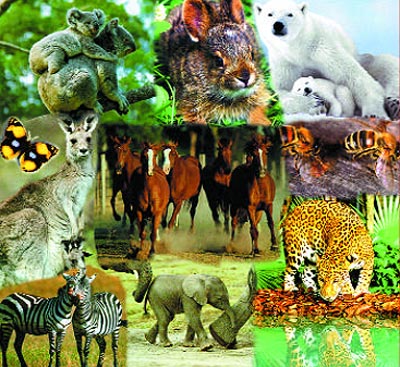The completion of the human's gene map today does not yield the result that man and ape are relatives. One need not be deceived by evolutionists' attempts to exploit this new scientific development just as they have done with all others.
As known, the recent completion of the human gene map within the scope of the Human Genome Project was a very important scientific advance. However, some results of this project are being distorted in some evolutionist publications. It is claimed that the chimpanzee genes bear a 98% similarity to human genes and this is promoted as an evidence for the claim that apes are related to humans, and therefore, to the theory of evolution. In truth, this is a "fake" evidence put forward by evolutionists who take advantage of the lack of knowledge about this subject in society.

First, it should be stated that the concept of 98% similarity between human and chimpanzee DNA frequently advanced by evolutionists is deceptive.
In order to claim that the genetic make-up of man and chimpanzee bear a 98% similarity, the genome of the chimpanzee also has to be mapped, just like that of man, the two have to be compared, and the result of this comparison has to be obtained. However no such result is available, because so far, only the human gene has been mapped. No such research has yet been done on the chimpanzee.
In reality, the 98 % similarity between human and chimpanzee genes, which now and then enters the agenda, is a propaganda-oriented slogan deliberately invented years ago. This similarity is an extraordinarily exaggerated generalisation grounded on the similarity in the amino acid sequences of some 30-40 basic proteins present in man and the chimpanzee. A sequence analysis has been made with a method named "DNA hybridization" on the DNA sequences that are correlated with these proteins and only those limited number of proteins have been compared.
However there are about one hundred thousand genes, and therefore one hundred thousand proteins encoded by these genes in humans. For that reason, there is no scientific basis for claiming that all the genes of man and ape are 98% similar just because of the similarity in 40 out of 100,000 proteins.
On the other hand, the DNA comparison carried out on these 40 proteins is also controversial. This comparison was made in 1987 by two biologists named Sibley and Ahlquist and published in the periodical named Journal of Molecular Evolution.15 However another scientist named Sarich who examined the data obtained by these two scientists concluded that the reliability of the method they used is controversial and that the data has been exaggeratedly interpreted.16
Dr. Don Batten, another biologist, also analysed the issue in 1996 and concluded that the real similarity rate is 96.2%, not 98 %.17
Moreover, the above-mentioned basic proteins are common vital molecules present in various other living things. The structure of the same kinds of proteins present not only in chimpanzee, but also in completely different living creatures, is very similar to that in humans.
For example, the genetic analyses published in New Scientist have revealed a 75 % similarity between the DNAs of nematode worms and man.18 This definitely does not mean that there is only a 25% difference between man and these worms! According to the family tree made by evolutionists, the ween man and these worms! According to the family tree made by evolutionists, the Chordata phylum, in which man is included, and the Nematoda phylum were different from each other even 530 million years ago.
On the other hand, in another finding which also appeared in the local media, it was stated that the comparisons carried out between the genes of fruit flies belonging to the Drosophila species and human genes yielded a similarity of 60%.19
In another case, analyses done on some proteins show man as closely linked to some very different living things. In a survey carried out by researchers in Cambridge University, some proteins of land-dwelling animals were compared. Amazingly, in nearly all samples, human beings and chickens were paired as the closest relatives. The next closest relative was the crocodile.20
Another example used by evolutionists on "the genetic similarity between man and ape", is the presence of 48 chromosomes in chimpanzees and gorillas versus 46 chromosomes in man. Evolutionists regard the closeness of the number of chromosomes as indication of an evolutionary relationship.
However, if this logic used by evolutionists were valid, then man would have an even closer relative than the chimpanzee: "the potato"!. Because the number of chromosomes in potatoes is the same as that of man: 46
These examples confirm that the concept of genetic similarity does not constitute evidence for the theory of evolution. This is because the genetic similarities are not in line with the alleged evolutionary schemes, and on the contrary, yield completely opposite results.

A headline from a popular newspaper in Turkey: "It is discovered that we are relatives with flies!". A fruit fly, whose genetic code has been mapped surprised scientists. The genes of the fly are similar to those of man's by 60%.

On the earth, there are distinctively designed systems of enormous perfection within the bodies of millions of living beings. The vast diversity and detailed design in all living beings from the smallest to the biggest shows us the infinite Power of our Creator
Unsurprisingly, when the issue is evaluated as a whole, it is seen that the subject of "bio-chemical similarities" does not constitute evidence for evolution, but rather leaves the theory in the lurch. Dr. Christian Schwabe, a biochemistry researcher from the Medical Faculty of South Carolina University, is an evolutionist scientist who has spent years searching for evidence for evolution in the molecular domain. In particular he carried out research on insulin and relaxin-type proteins and tried to establish evolutionary relationships between living beings. However, he had to confess many times that he could not find any evidence for evolution at any point in his studies. In an article published in a scientific journal, he said;
Molecular evolution is about to be accepted as a method superior to palaeontology for the discovery of evolutionary relationships. As a molecular evolutionist I should be elated. Instead it seems disconcerting that many exceptions exist to the orderly progression of species as determined by molecular homologies; so many in fact that I think the exception, the quirks, may carry the more important message.21
Based on the recent findings obtained in the field of molecular biology, the renowned biochemist Prof. Michael Denton made the following comments;
Each class at molecular level is unique, isolated and unlinked by intermediates. Thus, molecules, like fossils, have failed to provide the elusive intermediates so long sought by evolutionary biology… At a molecular level, no organism is "ancestral" or "primitive" or "advanced" compared with its relatives… There is little doubt that if this molecular evidence had been available a century ago… the idea of organic evolution might never have been accepted.22
It is surely natural for the human body to bear some molecular similarities to other living beings, because they all are made up of the same molecules, they all use the same water and atmosphere, and they all consume foods consisting of the same molecules. Certainly, their metabolisms and therefore genetic make-ups would resemble one another. This, however, is not evidence that they evolved from a common ancestor.
This "common material" is not the result of an evolution but of "common design", that is, their being created upon the same plan.
It is possible to explain this matter with an example; all construction in the world is done with similar materials (brick, iron, cement, etc.). This, however, does not mean that these buildings "evolved" from each other. They are constructed separately by using common materials. The same holds for living beings as well.
Life did not originate as the result of unconscious coincidences as evolution claims, but as the result of the creation of God, the Almighty, the possessor of infinite knowledge and wisdom.
Your Lord said to the angels, I am going to create a human being out of clay. When I have formed him and breathed into him of My Spirit, fall down in prostration to him! (Surah Sad: 71-72)
In addition to all the information we have detailed so far, we think it would be helpful to emphasize another fact.
Other than the superficial similarity between them, apes are no closer to human beings than other animals. Moreover, when intelligence is used as a point of comparison, the bee, which produces the geometrical wonder of the honeycomb, or the spider, which produces the engineering wonder of the web, are closer to man than the ape. We can even say that they are superior in some aspects.
Between man and ape, however, there is a tremendous gap, never to be closed by fairy stories. After all, an ape is an animal no different from a horse or a dog in terms of consciousness. Man, however, is a being who has consciousness and will, who can think, talk, reason, decide, and judge. All these qualities are functions of the "spirit" he possesses. The most important difference that causes this huge gap between man and other living beings is this "spirit". No physical resemblance can close this gap between man and other living beings. The only being that has "spirit" in nature is man.
In the Qur'an, this superior quality which man possesses and which differentiates him from other living things is referred to as follows:
Then He formed him and breathed His Spirit into him and gave you hearing, sight and hearts. What little thanks you show! (Surat as-Sajda: 9)
15 Sibley and Ahlquist, Journal of Molecular Evolution, vol. 26, p. 99-121 ![]()
16 Sarich et al. 1989. Cladistics 5:3-32 ![]()
17 C. E. N. 19(1): 21-22, December 1996-February 1997 ![]()
18 New Scientist, 15 May 1999, p. 27 ![]()
19 Hürriyet daily, 24 February 2000 ![]()
20 New Scientist, v. 103, 16 August 1984, p. 19 ![]()
21 Christian Schwabe, "On the Validity of Molecular Evolution", Trends in Biochemical Sciences, July 1986 ![]()
22 Michael Denton, Evolution: A Theory in Crisis. London: Burnett Books, 1985, p. 290-291. ![]()